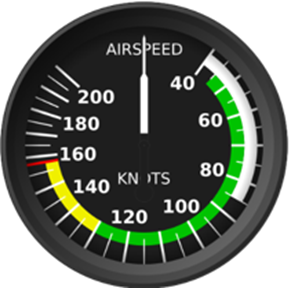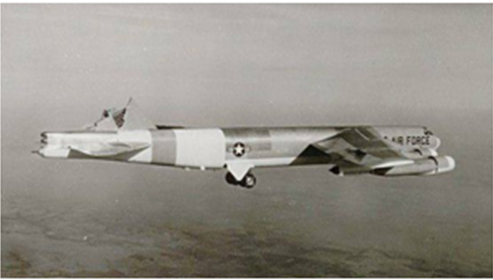by John Picone, PPL/INRAT Ground School Instructor, Brantford Flight Center
Airspeed indicator
Credit: Wikipedia
Turning to a page in the manual, the car salesman excitedly pointed out two newly developed features of the car I was interested in purchasing. “Now, as it says here on page 44, if you drive at or below this speed— 48 km/hr—no matter how treacherous the pothole you hit, you will not damage the suspension or cause the steering to go out of alignment. Just drive at or below this speed.” He continued, with a voice of cautious tone: “Now, hit a pothole above this speed and, well, a wheel could fall off.” He pointed to the digital speedometer on the instrument panel. “And just to remind you that you better be on smooth pavement when you go above this speed; once you hit 49 km/hr, the numbers on the speedometer are in yellow, which means caution!”
After expressing my amazement, I asked about the other newly developed feature. “This one’s even better,” he smiled. “It has to do with a sudden change of direction in the event of an emergency, like swerving to avoid a deer that’s just jumped in front of you.” Living in the country, I was quite interested in this feature and invited his explanation. “Well,” he continued, “If you drive at or below this speed—60 km/hr—you can make a sudden turn, and the car is guaranteed to not roll over.” He drew my attention to the manual: “You’ll notice there’s a list of rollover speeds. The heavier you are, the faster you can go. So, if you’re on the way to the airport with passengers and some luggage, you can swerve to miss that deer at a faster speed and not wind up in the ditch. But once you drop them off: Slow down!”
These are, of course, imaginary safety features of an automobile, but they serve to illustrate the concepts that underlie two V-speeds when we fly: Vno—Normal Operating/Maximum Structural Cruising Speed—and Va—Maneuvering Speed. I find these automobile images help my ground school students understand the important limits of Vno and Va.
Prior to learning about and understanding the significance of these speeds, the class has learned about load factor and G-forces and the impact these have on an aircraft’s stall speed. This is a necessary context.
“Those nice, white, pretty, puffy clouds you see on a summer’s day usually mean there are potholes in the sky,” I tell my class (more on that when we study meteorology). We can often predict turbulent air, but sometimes we cannot, especially in the world of general aviation, where sophisticated on-board weather radar is usually not found in the array of cockpit instruments. The proficient pilot, however, would be aware of conditions that could lead to turbulence, especially CAT—clear air turbulence. I emphasize the importance of checking PIREPs to become aware of potentially turbulent conditions. Aviators in mountainous regions need to be particularly vigilant.
B-52 with tail fin was sheared off
Credit: Wikipedia
In January 1964, the B-52 Stratofortress pictured here unexpectedly encountered severe turbulence at 14 000 ft ASL over New Mexico. The stresses caused by the turbulence were too much, exceeding load factors, and the tail fin was sheared off. Fortunately, the crew was able to safely land the plane several hours later.
A key difference between these two speeds, Vno and Va, is found in their very definitions. While the “no” in Vno is conveniently remembered as “n”ormal “o”perating speed, the definition most commonly given is “maximum structural cruising speed.” The key word here is “cruising.” If we return to the car analogy, the pothole speed applies to the car cruising along a road. Presumably in somewhat of a straight line. Va, by contrast, offers another image in its definition: “design maneuvering speed.” This connotes some change in direction. For the automobile, it suggests turning; in the airplane, it implies movement around any axis: roll, pitch or yaw.
Respect for both of these speeds will keep the pilot from bending, breaking or cracking something on the aircraft.
The part of the definition of Va that befuddles many students is the explanation that if a pilot flies at or below the maneuvering speed, “the plane will stall before it breaks.” That is to say that the aircraft will stop flying before a load factor that will overstress its structure is imposed on it. An understanding of this will also help the student grasp why it is that Va decreases as weight decreases and vice versa. Rookie pilot logic says “If I’m lighter, I should be able to go faster!”
We’ll start with a couple of givens: first, doubling the angle of attack doubles the load factor. In other words, if I suddenly pull back on the stick and increase my AoA from 3° to 6°, I will experience a load factor of 2, or 2 Gs. Next, we’re going to say that the airplane in our lesson stalls at 16° angle of attack (the critical angle of attack for most small aircraft is between 15° and 18°). Let’s also give our aircraft a weight of 3000 lbs and a cruising speed of 120 KIAS. To maintain level flight at this weight and speed, the AoA is 3°. Finally, the maximum rated load factor is +4 Gs. Beyond this load factor, the manufacturer—Mr. Cessna or Ms. Piper—tells us in the POH that the structure of the aircraft experiences stresses that are dangerous; something could bend, break or crack.
Now, if I were to really yank back on the stick and effectively quintuple the angle of attack from 3° to 15°, I will impose on the aircraft a load factor of 5: more than the maximum rated load factor of 4. But I would still be flying because the critical angle of attack is 16°. Something could bend, break or crack.
What if I slow down to 100 KIAS? Now, to maintain level flight at 3000 lbs, I need to increase my angle of attack to, let’s say, 4.5°. This time, I suddenly pull back on the stick and quadruple the AoA from 4.5° to 18°. Do I also quadruple the “weight” and impose a load factor of 4? Not quite! The plane would stall at 16°, 2 degrees before I got to four times the load factor. Falling forward in the stall, the stressful loading on the wings is relieved before reaching the critical load factor of 4, thus preserving the structural integrity of the aircraft.
Now, the question of weight. Let’s say I land and say goodbye to 300 lbs worth of passengers and their baggage before taking off again. At 100 KIAS, weighing now 2700 lbs, level flight only needs 3° AoA. Ah… now we’re back to the same problem we had initially. Solution: slow down even more. The generally accepted formula is 2% change in weight (increase or decrease) = 1% change in maneuvering speed. 300 lbs is 10% of the pre-unloading weight of 3000 lbs. So, we reduce our speed by 5% from 100 KIAS to 95 KIAS. This will necessitate an increase in AoA to, let’s say, 4.5°. And we know that’s safe.
The class has already learned that the stalling speed of an aircraft increases by a factor of the square root of the load factor. If the load factor is 2 (as in a 60° banked turn), then the stall speed is multiplied by 1.41, the square root of 2. We can use this same concept to understand how Va is calculated for an aircraft. Let’s say that the stalling speed of an aircraft is 55 KIAS and the maximum rated load factor, as in the example above, is 4. At this maximum load factor, the stalling speed would double; the square root of 4 is 2. Therefore, the maneuvering speed of the aircraft would be 110 KIAS: the stalling speed of 55 KIAS times 2. In other words, if the aircraft is flying at or below 110 KIAS–Va should it encounter a sudden gust of wind that quadruples the load factor, it will stall before it exceeds its maximum rated load factor of 4.
The important test question has to do with a change in weight on a multi-leg cross-country flight. Examiners routinely ask students to recalculate weight and balance to determine a revised center of gravity when fuel has been burned off and the aircraft payload changes. The same applies to a revised maneuvering speed.
For example, a Cessna 172N departs with a take-off weight of 1950 lbs. The Pilot Operating Handbook (POH) indicates that the maneuvering speed at this weight is 89 KIAS. The plane flies for 3 hours, burning 10 GPH (6 lbs per USG). After landing, 50 lbs of baggage is unloaded, as well as the rear passenger, who weighs 160 lbs. Before taking off again, the proficient pilot calculates the new maneuvering speed. Recall that 2% weight = 1% speed.
Loss of weight in fuel: 3 x 10 x 6 = 180 lbs + 50 lbs luggage + 160 lbs passenger = 390 lbs total weight loss.
Now we need to determine by what percentage the take-off weight has been decreased.
390 ÷ 1950 x 100 = 20%. So, if the weight has been decreased by 20%, then the maneuvering speed decreases by 10%. Taking off on the second leg of the cross-country flight at a weight of 1560 lbs, the new Va is 89 – 10% = 80.1 KIAS. And in the case of Va, we always round down; that’s the safest.
Student pilots’ awareness of the change in maneuvering speed (Va2) when aircraft weight configurations change is essential knowledge, as is the skill to determine it.
Failure to respect this could cause a new pilot to be really stressed out!

